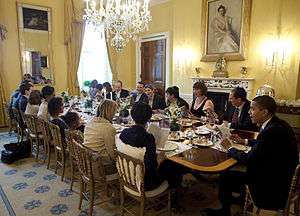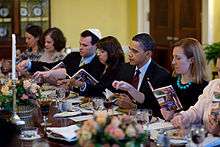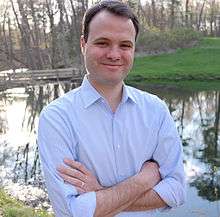White House Passover Seder

The White House Passover Seder is an annual private dinner held at the White House by President Barack Obama for his family, staff members, friends and their families, on the Jewish holiday of Passover. The gathering recites the Passover Haggadah, discusses the themes of the Seder and their relation to current events, and partakes of a holiday-themed meal. Held annually since 2009, it is the first Passover Seder to be conducted by a sitting U.S. president in the White House.
History
The White House Passover Seder had its origins in an informal Passover Seder conducted on April 19, 2008, by three junior staff members of then-presidential candidate Barack Obama's campaign. At the time, Obama and his campaign team were in Harrisburg, Pennsylvania, in advance of the Pennsylvania primary, and the Jewish staffers realized they would not be able to go home to be with their families on Seder night. The three staffers – Eric Lesser, Herbie Ziskend, and Arun Chaudhary – obtained a "Passover kit" with wine, matzo, macaroons, and Haggadahs from the Hillel House at the University of Pennsylvania and were conducting a late-night Seder in a meeting room of the Sheraton Hotel in Harrisburg when Obama walked in. "Hey, is this the Seder?" Obama asked. He and a group of aides, all non-Jews, joined in to recite the Haggadah. Obama was familiar with the ritual, having attended Passover Seders for the past nine years. At the end of the Seder, when the assembled said the traditional wish, "Next year in Jerusalem", Obama added, "Next year in the White House".[1][2]
The following year, with Obama elected president and his junior staffers working in the White House, Obama encouraged the group to hold the Seder again.[1] The 2009 event was the first time that a sitting U.S. president conducted a Passover Seder in the White House.[1][3][4] (In 1993 staffers of President Clinton conducted a Seder in the White House in the absence of the President.[4]) The White House switchboard was reportedly swamped with callers seeking a dinner invitation.[5] The White House Seder was scheduled for the second night of Passover to allow Jewish staffers to spend the first Seder on the first night of Passover with their families.[4] About 20 guests sat around a table in the Old Family Dining Room reading the Haggadah and sampling the traditional Seder foods. Malia and Sasha Obama, being the youngest in attendance, engaged in the search for the afikoman[2] and recited the Four Questions.[6] The Seder has been held each year since.[1]

During a visit to Israel in 2013, Obama stated that he brought the Passover Seder to the White House to acquaint his daughters with the story of the Exodus, whose themes resonate with his personal beliefs.[7][3] He said:
To African Americans, the story of the Exodus was perhaps the central story, the most powerful image about emerging from the grip of bondage to reach for liberty and human dignity – a tale that was carried from slavery through the Civil Rights Movement into today. For me, personally, growing up in far-flung parts of the world and without firm roots, the story spoke to a yearning within every human being for a home.[3]
Among the annual traditions for the While House Passover Seder are Obama's imitation of Pharaoh, Chaudhary's speech on the Hillel sandwich, and the hiding of the afikoman under the watchful eye of a Secret Service member.[1][6] The Seder convenes in the Old Family Dining Room and lasts for two hours.[8] During Obama's last year in office in 2016, the Seder was held on April 26,[9] the sixth day of Passover, due to Obama's previously scheduled visit to Saudi Arabia on the first and second nights of Passover.[10]
Themes

The White House Seder participants, many of them African Americans, are cognizant of the similarities between the story of the Israelite' Exodus from Egypt and the American civil rights movement. The themes of social justice, struggle, and freedom are often evoked during discussion at the meal.[1] At the point in the ritual when the prophet Elijah is welcomed to the meal, the guests recite the Emancipation Proclamation.[1]
The choice of serving pieces is also symbolic. In 2009, the group used silverware from the Truman administration, remembering Truman as the first President to recognize Israel.[1] In 2013, Israel First Lady Sara Netanyahu gave as a gift a Seder Plate, which is used each year at the dinner.[1][7] Those in attendance read from the Maxwell House Haggadah, which is widely used in Jewish homes.[7][6]
Menu

The menu at the White House Passover Seder features traditional Jewish Passover cuisine such as gefilte fish, charoset, chicken soup with matzah balls, brisket, potato kugel, and macaroons.[6][11] Salads and vegetable side dishes round out the menu.[11] Lesser brings handmade shmurah matzah from the Chabad-Lubavitch center in Springfield, Massachusetts.[12] Family recipes are emphasized; in 2015, these recipes included matzo ball soup from Ziskend's grandmother, carrot soufflé from Lesser's mother, and Raspberry Ganache Marjolaine from Chaudhary's mother.[11] Recipes include foods from both the Ashkenazic and Sephardic traditions.[11] The food is not strictly kosher, but kosher style.[13] In 2014, the White House Passover Seder began inviting a guest chef to coordinate the menu with the White House executive chef.[11]
Guest list
Unlike the White House Hanukkah Party, the White House Passover Seder is not a political event. The guest list does not include rabbinical figures, Jewish lobbyists, members of Congress, or Israeli representatives.[1][7] The guest list of approximately 20 remains basically the same each year.[6] Attendees include the president and his family, members of the president's and first lady's staff and their families, and friends of the Obamas, with a mix of Jews and non-Jews.[7]
See also
References
- 1 2 3 4 5 6 7 8 9 10 Raushenbush, Paul Brandeis (14 April 2014). "How Three Jewish Junior Obama Staffers Brought The First Passover Seder To The White House". The Huffington Post. Retrieved 3 April 2016.
- 1 2 Kantor, Jodi (27 March 2010). "Next Year in the White House: A Seder Tradition". The New York Times. Retrieved 3 April 2016.
- 1 2 3 Cook, David T. (25 March 2013). "Why Obama, a Christian, hosts a Passover seder each year at White House". The Christian Science Monitor. Retrieved 3 April 2016.
- 1 2 3 Lee, Carol E.; Parnes, Amie (8 April 2009). "Obama to host Seder at W.H.". Politico. Retrieved 3 April 2016.
- ↑ Zeleny, Jeff (9 April 2009). "Obama Hosts Seder Dinner at White House". The New York Times. Retrieved 3 April 2016.
- 1 2 3 4 5 Ferst, Devra (21 March 2013). "How is the White House Seder Different from All Others?". The Forward. Retrieved 3 April 2016.
- 1 2 3 4 5 Fabian, Jordan (3 April 2015). "Iran deal, Israeli tensions put focus on White House Seder". The Hill. Retrieved 3 April 2016.
- ↑ Donn, Yochanon. "Obama's Seder Waiver". Hamodia, U.S. News, April 21, 2016, p. 40.
- ↑ Abramson, Jerry (29 April 2016). "Why was this Night Different from All Other Nights: An Eighth and Final Seder in the White House". The White House. Retrieved 12 May 2016.
- ↑ "Obama to host late Passover seder this year". Jewish Telegraphic Agency. 19 April 2016. Retrieved 12 May 2016.
- 1 2 3 4 5 Nosanchuk, Matt (3 April 2015). "Celebrating Passover at the White House". The White House. Retrieved 3 April 2016.
- ↑ Dovere, Edward Isaac (15 April 2016). "Obama's final White House Seder will be late". Politico. Retrieved 18 April 2016.
- ↑ Mozgovaya, Natasha (19 April 2011). "Matzah Balls at the White House: Obama Hosts Third Passover Seder". Haaretz. Retrieved 3 April 2016.
External links
| Wikimedia Commons has media related to White House Passover Seder. |
- "Remember the Toddler Who Threw a Tantrum in Front of the President? That was my kid." Slate, November 18, 2015
